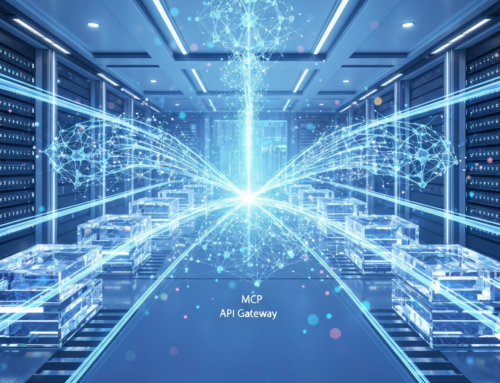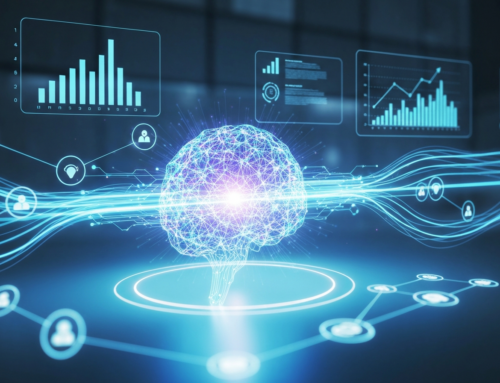The Dawn of Intelligent Efficiency: Understanding AI-Driven Workflow Automation
In today’s rapidly evolving business landscape, the integration of artificial intelligence is no longer a futuristic concept but a strategic necessity. AI-Driven Workflow Automation represents a profound shift in how organizations operate, moving beyond simple task automation to intelligent, adaptive processes. This involves leveraging AI-powered technologies and products to streamline tasks, analyze data, and enhance decision-making across an organization. Recent advancements in AI models and tools have opened new avenues for businesses to dramatically improve efficiency, reduce operational costs, and foster innovation.
Unlike traditional automation, which often relies on predefined rules, AI-driven workflow automation learns from data patterns, adapts to changing conditions, and makes informed decisions. This continuous learning capability allows systems to evolve, becoming more effective and precise over time. The ultimate goal is to create a continuously evolving and agile business that can respond dynamically to market demands and internal challenges.
Strategic Imperatives: Why Businesses Need AI Automation Now
The imperative for businesses to adopt AI automation is underscored by the tangible benefits it delivers. Companies that embrace AI in their transformation journey are more likely to outperform their competitors, as highlighted by an IBM Institute for Business Value report which found that 92% of executives agreed their organization’s workflows would be digitized and use AI-enabled automation by 2025. The strategic advantages include:
- Increased Productivity and Efficiency: AI automation handles repetitive, time-consuming tasks, freeing human employees to focus on higher-value, strategic, and creative work. This not only boosts individual productivity but also enhances overall organizational output. For instance, AI can process invoices, manage customer inquiries, or perform data entry with greater speed and accuracy than manual methods.
- Cost Savings: By automating operational tasks and optimizing resource allocation, businesses can significantly reduce labor costs and operational expenditures. AI-powered systems can identify inefficiencies and suggest improvements, leading to further savings.
- Enhanced Decision-Making: AI systems can analyze vast amounts of data in real-time, identify patterns, and provide actionable insights that support more informed and data-driven decisions. This predictive capability helps businesses anticipate market trends, optimize strategies, and mitigate risks effectively.
- Improved Accuracy and Reduced Errors: Automated workflows minimize the risk of human error in routine tasks, particularly in data-heavy fields like finance and healthcare where precision is critical. AI-driven systems follow predefined rules and data insights, ensuring consistent and accurate execution.
- Scalability: AI workflows allow operations to scale gracefully, handling increased volumes of work without a proportional increase in human effort. This is crucial for businesses experiencing rapid growth or facing fluctuating demands.
- Innovation and Competitive Advantage: AI serves as a catalyst for new ideas and long-term expansion. By quickly processing information and identifying emerging trends, AI enables businesses to develop new products, services, and business models that meet evolving customer needs, securing a competitive edge in the market.
Ultimately, AI-driven workflow automation empowers businesses to achieve hyper-efficiency, adaptive problem-solving, and resilience, positioning them for sustainable success in a dynamic digital economy.
Decoding the AI Stack: Key Components for Advanced Workflows
The backbone of any sophisticated AI-driven workflow is a robust AI stack, comprising various technologies that work in concert. Understanding these components is crucial for designing effective automation solutions:
- APIs (Application Programming Interfaces): APIs are fundamental connectors that enable different software applications, services, and systems to communicate and exchange data. In AI workflows, APIs facilitate the integration of AI models with existing business applications, allowing for seamless data flow and process orchestration.
- Business Process Automation (BPA) and Robotic Process Automation (RPA): BPA uses software to automate complex and repetitive business processes, often focusing on tasks like order processing or customer account management. RPA is a subset of BPA that employs intelligent automation technologies to handle routine office tasks, such as data extraction and form completion. When combined with AI, RPA becomes more adaptive and capable of handling exceptions.
- Generative AI (GenAI): This branch of AI creates original content, including text, images, video, audio, or code, in response to user prompts. GenAI, exemplified by tools like ChatGPT, can be used for content creation, summarizing information, setting up meetings, or even providing feedback on marketing copy, significantly enhancing productivity. McKinsey predicts gen AI might automate up to 10% of all tasks in the US economy.
- Intelligent Automation: A hallmark of AI-driven workflows, intelligent automation involves using automation technologies to streamline and scale decision-making. It enables systems to make judgments within their defined scope, handle exceptions, and interact with core enterprise systems in a dynamic way.
- Machine Learning (ML) and Deep Learning: ML uses data and algorithms to enable AI to learn and improve accuracy over time. Deep learning, a subset of ML, utilizes multilayered neural networks to simulate the complex decision-making of the human brain, making it particularly effective for tasks involving unstructured data.
- Natural Language Processing (NLP): NLP allows computers to understand, interpret, and generate human language. This is vital for AI applications involving customer service chatbots, sentiment analysis, content summarization, and translation services.
- Optical Character Recognition (OCR): OCR converts images of text into machine-readable formats. This technology is crucial for digitizing legacy documents, making them searchable and usable for AI models, and streamlining data entry processes.
These components form a powerful ecosystem, allowing businesses to build intelligent systems that can perceive, reason, plan, and act with a significant degree of autonomy.
Transforming Operations: Real-World Applications of AI-Powered Workflows
AI-driven workflow automation is reshaping operations across a multitude of industries, delivering measurable improvements and opening new avenues for efficiency and growth. Here are some prominent real-world applications:
Customer Service and Engagement
- Automated Support: AI-powered chatbots and virtual assistants handle routine customer inquiries, account management, and technical troubleshooting 24/7. This reduces wait times and allows human agents to focus on complex issues. For example, Camping World partnered with IBM to improve customer engagement by 40% and decrease wait times to 33 seconds thanks to AI workflows.
- Personalized Interactions: AI analyzes customer data to provide tailored recommendations and personalized content, enhancing the overall customer experience.
Finance and Accounting
- Invoice Processing: OCR technology extracts data from invoices, and AI algorithms match it against purchase orders and contracts, automating payment initiation and record updates. This speeds up approval processes and minimizes errors.
- Fraud Detection and Risk Assessment: AI analyzes financial transactions in real-time to identify anomalous patterns indicative of fraud, significantly reducing financial risk. An IBM Institute for Business Value study found executives anticipated generative AI improving their ability to predict anomalies, explain variances, generate scenarios (40%), and create reports.
Human Resources and Talent Management
- Recruiting and Onboarding: AI scans resumes to identify suitable candidates, automates interview scheduling, and streamlines onboarding processes, improving efficiency in talent acquisition.
- Personalized Development: AI can offer personalized feedback and career development advice, enhancing the employee experience.
Supply Chain and Operations
- Predictive Maintenance: Sensors collect data from machinery, and AI models predict equipment failures before they occur. Automated workflows then schedule maintenance and order parts, reducing downtime and extending equipment lifespan. IBM helped Toyota use AI to improve its predictive maintenance abilities, leading to a 50% reduction in downtime and an 80% reduction in breakdowns.
- Inventory Optimization: AI analyzes historical data and external factors to forecast demand, optimizing inventory levels and reducing waste.
Marketing and Sales
- Campaign Optimization: AI can automatically optimize ad campaigns, allocating funds to the highest-performing segments and social media posts, thereby maximizing ROI.
- Lead Scoring and Upselling: AI identifies the most promising sales prospects and analyzes customer data to suggest upselling opportunities, empowering sales teams to focus on high-value interactions.
These examples illustrate how AI-driven workflows are not just incremental improvements but fundamental transformations, enabling businesses to operate with unprecedented intelligence and agility. Microsoft, for instance, has compiled over 1,000 stories of customer transformation and innovation through AI, demonstrating its widespread impact across various sectors.
Leveraging Platforms and Agents: n8n, LangChain, and Custom Solutions
The rapid advancement of AI has been significantly bolstered by innovative platforms and frameworks that simplify the development and deployment of intelligent automation. Among these, open-source tools like n8n and frameworks like LangChain are becoming instrumental, particularly when combined with the power of custom AI agents.
n8n: The Workflow Orchestrator
N8n is a powerful open-source workflow automation tool that allows businesses to connect various applications, APIs, and services without extensive coding. Its user-friendly, drag-and-drop interface makes it accessible for creating complex workflows. Key features include:
- Extensive Integrations: N8n supports connections with hundreds of apps and services, making it a versatile hub for automating cross-platform tasks.
- Flexibility: It offers self-hosting options for greater data control and allows for custom nodes to implement unique logic and functions.
By acting as an orchestrator, n8n can trigger AI processes, feed data to AI models, and direct the output of AI back into other systems, creating seamless automated sequences.
LangChain: Powering Large Language Models
LangChain is a framework designed to facilitate the development of applications powered by Large Language Models (LLMs) such as OpenAI’s GPT-4. It simplifies the interaction with these complex AI models, making it easier to build applications that can understand and generate human-like text. Its core strengths lie in its:
- Ease of Use: Abstracting away much of the complexity of LLM interaction, allowing developers to focus on application logic.
- Versatility: Supporting a wide range of AI tasks, from content generation and summarization to translation and complex reasoning.
- Integration-Friendly Design: Working seamlessly with other tools and platforms, including workflow automation platforms like n8n.
Combining n8n with LangChain allows for the creation of intelligent systems that can automate tasks like generating email responses, scheduling social media content, or summarizing large datasets dynamically.
The Rise of AI Agents and Agentic Workflows
Beyond simple automation, the concept of AI agents is rapidly emerging as a strategic imperative. As discussed by Roland Berger, AI agents are sophisticated, self-directed digital entities capable of complex reasoning, planning, and executing multi-step processes across diverse systems to achieve strategic goals. They possess three key characteristics:
- Perception: They can sense and interpret their operational environment using various data inputs.
- Decision-Making (Reasoning & Planning): They utilize AI models (often LLMs) to reason, make informed decisions, and formulate plans to achieve predefined goals.
- Action: Crucially, they can act on their decisions by interacting with other systems, tools, APIs, or even other agents, adapting based on real-time feedback.
These agents can orchestrate complex workflows, collaborate with humans and other agents, drive intelligent automation, and enable continuous learning and adaptation. This shift from tools that humans use to digital collaborators demands a rethinking of business strategy and operational design, moving towards “agentic meshes” – dynamic, interconnected networks of specialized agents working in concert across an organization.
Custom solutions, often built with backend technologies like Python and FastAPI, allow for highly specialized AI agents and unique integrations, enabling businesses to develop truly differentiated automation capabilities tailored to their specific needs. This blend of off-the-shelf platforms, frameworks, and custom development empowers organizations to unlock new levels of performance and innovation.
Charting Your Course: A Strategic Framework for AI Automation Adoption
Implementing AI-driven workflow automation is a transformative journey that requires a clear, strategic framework. Successfully navigating this landscape involves careful planning, robust data management, and a commitment to responsible AI practices. According to Microsoft’s AI strategy guidance, a structured approach is key.
Here are critical steps for a successful AI automation adoption:
- Identify High-Impact Use Cases: Begin by pinpointing specific business processes where AI can deliver measurable value. Focus on areas with repetitive tasks, high error rates, or significant operational costs. Quantify the desired business outcomes (e.g., improved customer satisfaction, reduced costs) before focusing on the technology.
- Define an AI Technology Strategy: Select the appropriate AI service model (SaaS, PaaS, or IaaS) based on your organization’s engineering maturity, compliance needs, and customization requirements. For quick wins, leverage ready-to-use AI solutions like Copilots. For custom development and integration, platforms like Azure AI Foundry offer robust capabilities. Understand AI agents and plan for their integration into complex workflows.
- Develop a Robust Data Strategy: A scalable and trustworthy AI relies on high-quality, governed data. Establish data governance frameworks to ensure data is sourced, classified, secured, and managed in compliance with regulations. Implement ETL/ELT pipelines to maintain data quality and integrate lineage tracking to understand data origins and usage.
- Prioritize Responsible AI Practices: Embed ethical considerations throughout the AI lifecycle, from design to deployment. Assign clear ownership for AI governance, adopt responsible AI principles as business goals (e.g., fairness, transparency, accountability), and utilize tools like the Responsible AI Dashboard to detect and mitigate biases in training data and model outputs.
- Invest in Talent and Change Management: AI adoption often requires upskilling existing employees and potentially hiring new AI specialists. Develop training programs to equip your workforce with the necessary AI skills. Crucially, manage the organizational change by communicating the benefits of AI, addressing concerns about job displacement, and fostering a culture of empowerment where AI enhances human capabilities rather than replaces them. McKinsey research indicates that employees are often more ready for AI than leaders realize, emphasizing the importance of leadership in steering this transformation.
- Start Small and Scale Incrementally: Begin with pilot projects that offer clear, demonstrable value under strong governance. As internal expertise and confidence grow, iteratively expand the scope and complexity of AI deployments. This phased approach minimizes risk and builds momentum for broader organizational transformation.
- Monitor and Adapt Continuously: The AI landscape is dynamic. Regularly assess the performance of AI systems, monitor for emerging risks (e.g., model drift, security vulnerabilities), and adapt your strategy based on new insights and technological advancements. Continuous evaluation ensures that your AI initiatives remain aligned with business objectives and deliver sustained value.
By following this strategic framework, businesses can effectively navigate the complexities of AI automation, overcome potential challenges, and unlock the full potential of intelligent workflows to drive innovation and competitive advantage.
Partnering for Peak Performance: Idea Forge Studios’ AI Automation Expertise
At Idea Forge Studios, we specialize in transforming business operations through cutting-edge AI-driven workflow automation. Our expertise spans the entire spectrum of AI integration, from strategic consulting to hands-on implementation, ensuring our clients achieve peak performance and sustainable growth. We understand that successful AI adoption goes beyond technology; it requires a deep understanding of business processes, data ecosystems, and organizational culture.
Our approach is rooted in a professional, authoritative, and solution-oriented philosophy. We partner with small to medium-sized businesses and enterprises alike, guiding them through the complexities of AI automation with clear, expert language. Whether it’s leveraging powerful platforms like n8n and LangChain, developing custom AI agents for unique challenges, or integrating advanced backend technologies with Python and FastAPI, Idea Forge Studios delivers tailored solutions that drive tangible business outcomes.
We focus on strategic use cases, avoiding generic implementations, to ensure that every AI automation initiative directly contributes to enhancing online presence, improving operational efficiency, and securing a competitive edge. Our commitment is to demystify complex AI concepts, providing our clients with the insights and tools needed to make informed decisions and confidently navigate their AI transformation journey.
The Future is Automated: Unleashing Your Business’s Full Potential
The trajectory of business evolution points unmistakably towards a future where AI-driven workflow automation is not merely an advantage, but a foundational element for sustained success. As highlighted by Forbes, revolutionizing business with AI and automation is key to future success, enabling companies to remain competitive and innovative. This transformative power extends beyond simple efficiency gains, fostering entirely new ways of working and unlocking unprecedented levels of business potential.
The continuous evolution of AI models, the increasing sophistication of AI agents, and the growing accessibility of powerful automation platforms mean that businesses have more opportunities than ever to integrate intelligence into their operations. By embracing AI-driven workflow automation, organizations can:
- Redefine Employee Roles: Shifting human efforts from mundane, repetitive tasks to creative, strategic, and relationship-focused activities.
- Gain Deeper Insights: Leveraging AI’s analytical capabilities to uncover hidden patterns and predictive intelligence from vast datasets.
- Achieve Unmatched Agility: Building adaptable systems that can quickly respond to market shifts, customer demands, and unforeseen challenges.
- Drive Continuous Innovation: Using AI as a catalyst for new product development, service offerings, and business model transformations.
The journey towards full AI integration will involve navigating challenges related to initial setup costs, data governance, and change management. However, with thoughtful planning, strategic partnerships, and a commitment to continuous learning, these obstacles are surmountable. The organizations that proactively embrace this shift, leveraging AI to amplify human capabilities and streamline operations, will be best positioned to thrive in the intelligent economy. The future is automated, and it holds immense potential for businesses ready to unleash it.
Ready to revolutionize your business with AI-driven workflow automation? Partner with Idea Forge Studios to unlock unparalleled efficiency and innovation. Schedule a personalized consultation or call us at (980) 322-4500 to discuss your specific web development, e-commerce, or digital marketing needs today. You can also email us for inquiries.








Get Social